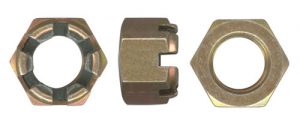 When researching some of the different types of nuts used in the aerospace manufacturing industry, you may come across castellated nuts. They are one of the most common types of non-self-locking nuts in airplanes. Castellated nuts are essentially castle nuts. They feature a perimeter of shallow ridges that resemble a medieval castle. For a better understanding of castellated nuts, keep reading.
When researching some of the different types of nuts used in the aerospace manufacturing industry, you may come across castellated nuts. They are one of the most common types of non-self-locking nuts in airplanes. Castellated nuts are essentially castle nuts. They feature a perimeter of shallow ridges that resemble a medieval castle. For a better understanding of castellated nuts, keep reading.
What Are Castellated Nuts?
Castellated nuts are fasteners that are designed for use with a pin-based locking fastener. They share many of the same characteristics as traditional nuts. Castellated nuts have a ring of internal threading in the center, which allows them to accommodate a fastener with external threading. You can twist a Castellated onto the end of a bolt.
Castellated nuts are distinguished from traditional nuts, however, by their ridges. As shown in the photo above, they don’t have a smooth and solid top. Rather, the top of a castellated nut has a perimeter of ridges. The ridges run completely around the top of the castellated nut, resulting in a castle-like appearance.
You can identify castellated nuts by looking for these ridges. Traditional nuts don’t have these same ridges. Most traditional nuts have a solid and smooth top, as well as a solid and smooth bottom.
How Castellated Nuts Work
With their ridges, castellated nuts can be used with pin-based locking fasteners. A pin-based locking fastener may consist of a bolt with a pre-drilled hole through the center along with a clotter pin. After twisting a castellated nut onto the end of a bolt, you can insert a clotter pin through the bolt’s pre-drilled hole.
Castellated nuts feature ridges so that a pin can be inserted through them and the bolt or fastener to which the castellated nut is connected. The pin is aligned so that it goes through two ridges of the castellated nut and the center of the fastener.
Airplanes use castellated nuts to protect fasteners from vibrations. Traditional nuts offer little or no protection against vibrations. When exposed to vibrations, they may loosen. Vibrations can cause nuts to gradually loosen or even slide off the fasteners with which they are used. Castellated nuts prevent this from happening by supporting the use of a pin.
In Conclusion
While they aren’t self-locking, castellated nuts support locking with a pin-based fastener. They work with clotter pins, hitch pins and other types of pins to secure fasteners in place.



